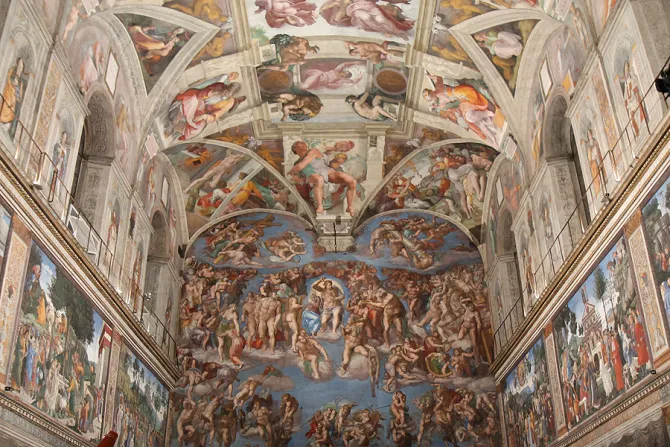Vatican City, Oct 31, 2014 / 13:11 pm
The first major makeover the Sistine Chapel has had since 1994 brings with it a completely new LED lighting system and high-tech sensors that automatically measure and adjust the chapel's oxygen levels.
"If you look at this art in the Sistine Chapel it is breathtaking," said John Mandyck, chief sustainability officer for UTC Building & Industrial Systems which has overseen the project.
"But ironically it is the act of breathing or exhaling carbon-dioxide that was destroying the frescoes."
He told CNA that the new technology will preserve the treasured frescoes – painted by Michelangelo 500 years ago – with the guarantee of future protection through adaptability.
"We have the ability to keep with the technology as technology advances and evolves over time," Mandyck said. "We expect it to last a long time."
The highly anticipated new ventilation systems were presented to journalists at an Oct. 29 press conference, which was part of a two-day event put on by the Vatican called "The Sistine Chapel 20 years later: New breath, New light" in honor of their official installment.
Created by Carrier, the U.S.-based pioneer of modern heating, ventilating and air-conditioning systems, the company has specially designed the new lighting, air-quality and temperature control system to fit the unique needs of the Sistine Chapel.
The company also designed and installed the chapel's first air-conditioning system in 1993 to accommodate a maximum load of 700 at once.
However with the current number of daily visitors to the chapel hitting close to 20,000, the new system is designed to accommodate up to 2,000 simultaneous visitors in nearly any weather condition, the company revealed.
Landing at $3.8 million dollars in improvements, the state-of-the-art systems have a custom LED lighting system which uses 7,000 lights in order to maximize illumination of the frescoes, giving them a softer, brighter look.
Scientists have run numerous tests on the more than 250 original colors present in the chapel's ancient frescos, attempting to see how the light would react with each.
Designed to be "imperceptible," the lights are completely hidden from sight, and are only seen when additional lighting is turned on for conclaves, concerts or other special events.
The lights themselves, according to designer LED4Art, a European Union-led project in collaboration with universities, will drastically save on energy in the chapel, and are expected to save roughly 60 percent on costs.
Along with the lights there are two cameras and 70 sensors placed throughout the chapel in order to register the environment inside and react to it. With the cameras estimating the number of people in the room, the purification and air-conditioning units adjust according to what the cameras register.
Completely silent, the units are designed to maintain a temperature of 20-25 degrees Celsius and 50-60 percent humidity within the chapel. They also guarantee that the number of dust particles remain at a level of 0.1 micrograms per cubic meter of air, and that the levels of CO2 levels are kept to a minimum.
Michel Grabon, Director of Carrier's AdvanTEC program in Europe, said that the new systems focus on three key aspects, which are advanced design, efficiency and intelligence.
The system, he explained to EWTN News on Oct. 29, "is particularly advanced (and) a very high technology level of the system that has been developed."
In reference to the system's efficiency, Grabon pointed out its particular quality in being energy efficient, "which is extremely important in our days – to have a system that is green and energy -efficient."
A third important element to note is that the new system is "extremely intelligent," he said, with for this type of system means that it's the first time a camera they've used a camera to count the people inside the chapel "and adjust air flow and the other system parameters just to meet the number of people inside."
Because it counts the number of people inside, the camera is also able to register the level of CO2 due to the amount that each person generates, Grabon noted.
"So if you know exactly how many people you have inside the chapel you know how much fresh air you need to bring to the chapel in order to bring down the CO2 level," he said, observing that the new systems are able to do this "very quickly."
Director of the Vatican Museums Antonio Paolucci told CNA in an interview over the summer that the chapel has had more than 5 million visitors per year since the number of visitors hit that mark for the first time in 2011.
In the Oct. 29 press conference, he said that their new aim with this innovation "is not restoration, but conservation."
This is, the director explained, "is why we have chosen Carrier, because a masterpiece like the Sistine Chapel needs a comparable masterpiece of technology."



